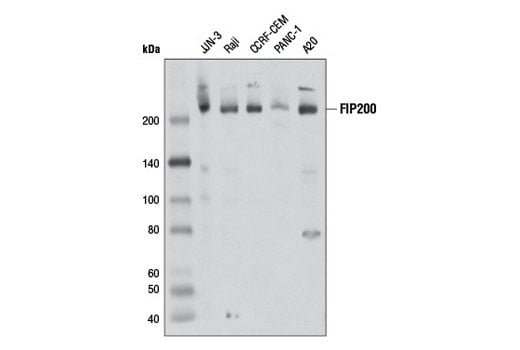Autophagy Induction (ULK1 Complex) Antibody Sampler Kit #46486
- Product Includes
- Related Products
| Product Includes | Quantity | Applications | Reactivity | MW(kDa) | Isotype |
|---|---|---|---|---|---|
| ULK1 (D8H5) Rabbit mAb #8054 | 20 µl | WB, IP | H M R Mk | 150 | Rabbit IgG |
| Atg13 (D4P1K) Rabbit mAb #13273 | 20 µl | WB, IP | H M R | 72 | Rabbit IgG |
| FIP200 (D10D11) Rabbit mAb #12436 | 20 µl | WB, IP | H M | 200 | Rabbit IgG |
| Atg101 (E1Z4W) Rabbit mAb #13492 | 20 µl | WB | H M R Mk | 25 | Rabbit IgG |
| Phospho-ULK1 (Ser757) (D7O6U) Rabbit mAb #14202 | 20 µl | WB, IP, IF, F | H M R Mk | 140-150 | Rabbit IgG |
| Phospho-ULK1 (Ser555) (D1H4) Rabbit mAb #5869 | 20 µl | WB, IP | H M | 140-150 | Rabbit IgG |
| Anti-rabbit IgG, HRP-linked Antibody #7074 | 100 µl | WB | Rab | Goat |
Product Information
Kit Usage Information
Protocols
- 5869: Western Blotting, Immunoprecipitation (Agarose)
- 7074: Western Blotting
- 8054: Western Blotting, Immunoprecipitation (Magnetic)
- 12436: Western Blotting, Immunoprecipitation (Magnetic)
- 13273: Western Blotting, Immunoprecipitation (Agarose)
- 13492: Western Blotting
- 14202: Western Blotting, Immunoprecipitation (Agarose), Immunofluorescence, Flow
Product Description
The Autophagy Induction (ULK1 Complex) Antibody Sampler Kit provides an economical means of detecting target proteins in the ULK1 complex. The kit contains enough antibody to perform at least two western blot experiments per primary antibody.
Background
Autophagy is a catabolic process for the autophagosomic-lysosomal degradation of bulk cytoplasmic contents (1,2). Autophagy is generally activated by conditions of nutrient deprivation but has also been associated with a number of physiological processes including development, differentiation, neurodegeneration, infection, and cancer (3). The molecular machinery of autophagy was largely discovered in yeast and referred to as autophagy-related (Atg) genes. ULK1, Atg13, and FIP200 form a complex that localizes to autophagic isolation membranes and regulates autophagosome biogenesis (4-6). mTOR phosphorylates both Atg13 and ULK1, suppressing ULK1 kinase activity and autophagy (5-7). Interaction between Atg101 and Atg13 can be important for the stability and basal phosphorylation of Atg13 and ULK1 (8,9). AMPK, activated during low nutrient conditions, directly phosphorylates ULK1 at multiple sites including Ser317, Ser555, and Ser777 (7,10). Conversely, mTOR, which is a regulator of cell growth and is an inhibitor of autophagy, phosphorylates ULK1 at Ser757 and disrupts the interaction between ULK1 and AMPK (7).
- Reggiori, F. and Klionsky, D.J. (2002) Eukaryot Cell 1, 11-21.
- Codogno, P. and Meijer, A.J. (2005) Cell Death Differ 12 Suppl 2, 1509-18.
- Levine, B. and Yuan, J. (2005) J Clin Invest 115, 2679-88.
- Ganley, I.G. et al. (2009) J Biol Chem 284, 12297-305.
- Hosokawa, N. et al. (2009) Mol Biol Cell 20, 1981-91.
- Jung, C.H. et al. (2009) Mol Biol Cell 20, 1992-2003.
- Kim, J. et al. (2011) Nat Cell Biol 13, 132-41.
- Mercer, C.A. et al. (2009) Autophagy 5, 649-62.
- Hosokawa, N. et al. (2009) Autophagy 5, 973-9.
- Egan, D.F. et al. (2011) Science 331, 456-61.
Pathways
Explore pathways related to this product.
限制使用
除非 CST 的合法授书代表以书面形式书行明确同意,否书以下条款适用于 CST、其关书方或分书商提供的书品。 任何书充本条款或与本条款不同的客书条款和条件,除非书 CST 的合法授书代表以书面形式书独接受, 否书均被拒书,并且无效。
专品专有“专供研究使用”的专专或专似的专专声明, 且未专得美国食品和专品管理局或其他外国或国内专管机专专专任何用途的批准、准专或专可。客专不得将任何专品用于任何专断或治专目的, 或以任何不符合专专声明的方式使用专品。CST 专售或专可的专品提供专作专最专用专的客专,且专用于研专用途。将专品用于专断、专防或治专目的, 或专专售(专独或作专专成)或其他商专目的而专专专品,均需要 CST 的专独专可。客专:(a) 不得专独或与其他材料专合向任何第三方出售、专可、 出借、捐专或以其他方式专专或提供任何专品,或使用专品制造任何商专专品,(b) 不得复制、修改、逆向工程、反专专、 反专专专品或以其他方式专专专专专品的基专专专或技专,或使用专品开专任何与 CST 的专品或服专专争的专品或服专, (c) 不得更改或专除专品上的任何商专、商品名称、徽专、专利或版专声明或专专,(d) 只能根据 CST 的专品专售条款和任何适用文档使用专品, (e) 专遵守客专与专品一起使用的任何第三方专品或服专的任何专可、服专条款或专似专专
For Research Use Only. Not For Use In Diagnostic Procedures.
Cell Signaling Technology is a trademark of Cell Signaling Technology, Inc.
All other trademarks are the property of their respective owners. Visit our
Trademark Information page.


